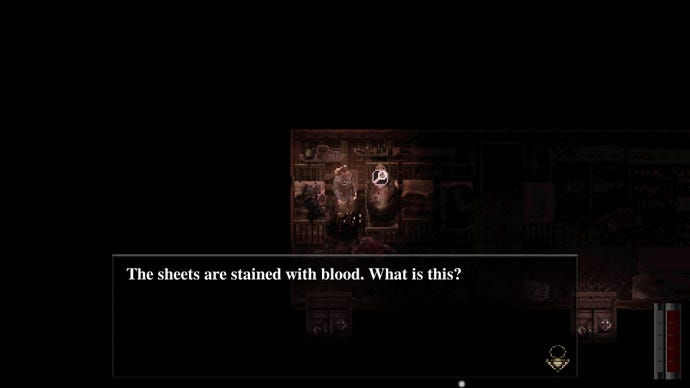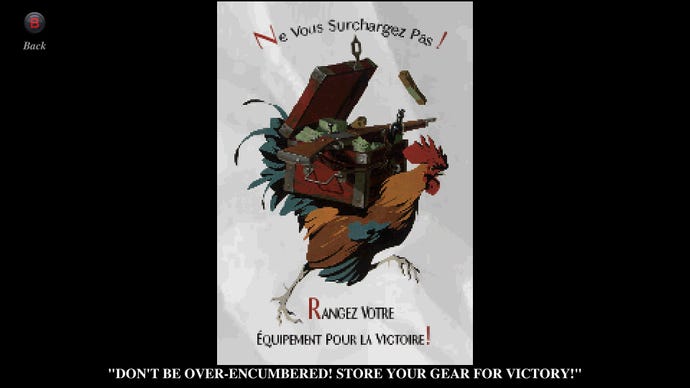Conscript review: sturdily crafted and gruelling WW1 survival horror
Do green herbs work for trench foot?
Take me back to the soft blue light, Conscript. It’s safe there, in the save room. No body-armoured heavies with trench raiding clubs. No tunnels choked with sickly, mushy-pea green gas. No rats feasting on my ankles, occasionally inflicting a disease that halves my health bar. “Christ, they’re sending runners now?” the rifleman asks as I hoof south from Fort Souville after a gruelling trench defence whittles down my resources to a busted fightin’ spade and a handful of pistol bullets.
“Are we fucked?”
What a keen misery is it to realise it’s me rushing for aid - not the rotting horse corpses or the shell-shocked shaking in silent corners - that tips him off to encroaching disaster. I suppose spending so long in hell means gradual adjustments in temperature don’t really register.
I could really use that blue light. Set in 1916 during the battle of Verdun, comforts are few and far between. Still, here’s a comfort if you had your eye on this one: While Conscript dresses survival horror’s cadaver in personal and occasionally playful ways to suit its own purposes, this is a craftspersonly sturdy implementation of the genre’s bones. It leaves a few mainstays on the table, sure. Puzzles run simple, and persistent despair replaces overt scares, but all the better for pacing and atmosphere. Its Spencer Mansion-esque interlocking environments run denser and larger than most, too. Again, for the better. The genre’s best placed safe rooms act as rhymes that support the metre, and here each excursion cycle feels like being flung out into a rot and rat-shit speckled labyrinth, threadless.

Not quite threadless, granted. You’ll find maps - good ones at that - marking not just locked doors but specifics. Notes tell you which keys for which doors, or where certain puzzles you'll want to return to are. But disorientation and danger still arise from dense, claustrophic interiors and how regularly areas repopulate with enemies after progression points. Here’s a minor heresy for purists: you can’t really avoid the vast majority of combat encounters here. You can sometimes, slipping into designated spots to wait out a passing patrol. Most of the time, though, you’re going to be glad you kept a designated inventory slot for spare bullets.
I fought off said patrols with a controller. Left trigger to aim, right to fire, with crosshairs that focus the longer you steady your shot. Pistols are relatively weak but offer the advantage of not having to chamber every shot like the more effective rifle, and these minor points of interruption feel both authentic and pant-pissingly tense in the middle of a fight. We’re not made of bullets though, soldier, so you’d better get acquainted with the ancient and noble art of swinging a spade at a man’s skull.
Melee works similarly to guns, aim and swing, with a few odd quirks. Stagger feels very inconsistent in Conscript, although I found I could mostly reliably cancel an opponent’s melee attack if I swung at the very top of their swing’s pullback. Also, have fun cracking barrels. Your melee weapons don’t degrade hitting inanimate objects, which is nice, but also you have to wait until the crosshair focuses to reliably hit a barrel you’re standing right next to. I know, I know. Small potatoes. There’s a war on, etc. Those stagger inconsistencies were a bit of a sticking point for me, though. I suppose there has to be a semi-random element since you can’t aim at certain parts with the isometric viewpoint, but when resource usage and combat spacing are so vital, it feels worse to be cheated out of breathing room than it feels triumphant to be gifted it. Still, the dodge roll is an incredibly useful tool for making space, if you’ve got the stamina for it.

What does feel triumphant, gratifying even, is the sort of toned-down Resident Evil 4 loop of treasure hoarding to spend on resources and weapon upgrades. I say treasure - it’s mostly cigarettes, but occasionally you find a massive ruby or other precious gem. The description tells me these were probably unearthed by artillery. I can’t speak to whether this is a stretch or not, but it does feel like Conscript would become unbearably bleak - and discourage optional exploration besides - without some sort of traditional reward loop. I’m not saying this necessarily undermines the atmosphere, it's just interesting to pinpoint the compromises - although nothing cuts through melancholy like an achievement named “What’re ya buying?” popping up.
Elsewhere, though, Conscript makes this stuff work for it. You’ll be called to the frontline at intervals. I’m not sure I’ve ever had a turret section feel less like a power fantasy. The crosshair shakes and shudders violently. German soldiers pile in groups of two, three, until every tool at your disposal is spent - then they pile in some more. A twist on Resident Evil 1 Remake’s crimson heads soon sees rats infest crucial routes until you put a stop to the source. The setting offers up enough hazards so that unlocking new areas with gas masks and dynamite feel like the actions of a resourceful, desperate soldier, as does crafting makeshift molotovs and medical supplies.
Again, though, it’s that underpinning machinery of map design, lock-and-key progression, and exploration flow that dams up an unbelievably bleak tale from ever draining into dreariness. Conscript is frequently stop-and-stare arresting in its implementation of jaundiced light and grim colour, its many creative uses of a palette largely limited to blood, rot, shit, and shell casings. But while Resi has camp, Signalis romance, and Silent Hill baroque profundity, Conscript has little to fall back on, save the grim promise of either the meat grinder or the deserter’s bullet. That is not an easy setup to make appealing and to inspire pushing on, but the game manages it. In much horror, hell is a place we descend to through decreasingly mundane thresholds. Here, it’s where we start.

There are salves. Terse, gallows-humour fortified conversations and opportunities to help your comrades by giving away precious items. The search for your wounded brother, made poignant through flashbacks that don’t need to lay on the sentiment, since just being away from the trenches for a little while is enough to evoke relief and comfort. One chapter opens up to a combat-less journey through devastated countryside - a well-placed show of confidence in an atmosphere of threat and trepidation to sustain itself when the bullets stop flying.
It can be tricky to assess the balance in a genre that relies on making you feel hopeless, threatened and, yes, a little bit tilted occasionally. Resources feel plentiful, initially, and so I feasted until famine struck and I had to abandon my first run, which honestly just made me respect Conscript more for committing to it. If this isn’t your bag, there’s four difficulty settings, plus options to enable checkpoints and unlimited saves - in saferooms still, but without needing to use an ink consumable. Also included are mainstays like playthrough ranks and unlockable costumes. And - ohoho! - an honest-to-god digital manual, complete with a blank notes page. Love it. The way I just structured that paragraph now necessitates I make it clear I’m not just saying this because of the manual, but: Conscript is good survival horror. Fill your boots. Check for rats first though, innit.
This review is based on a review build of the game provided by the developer.

